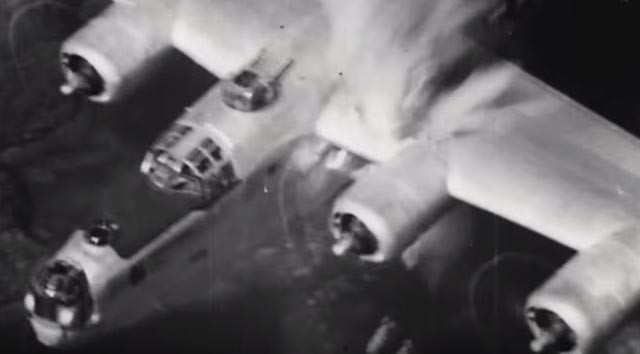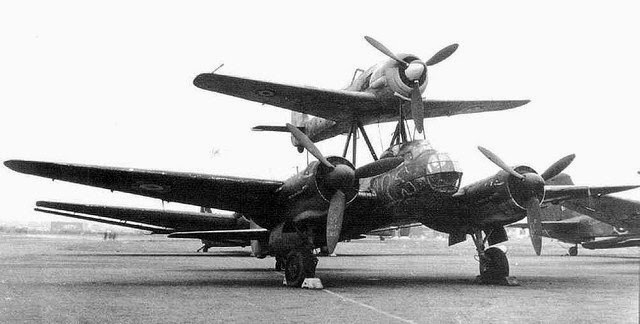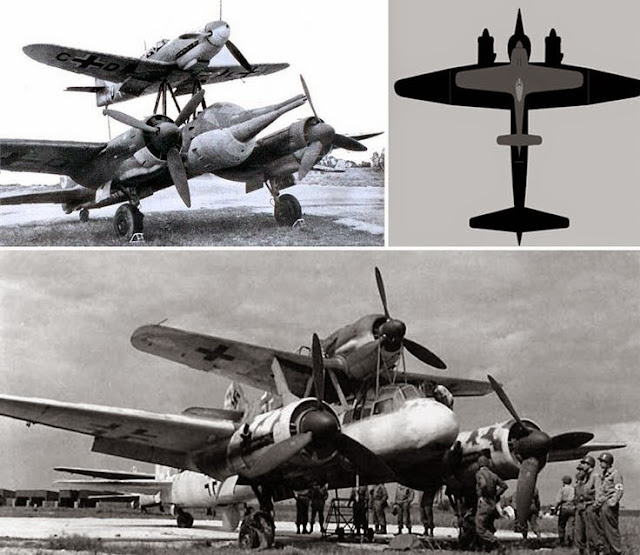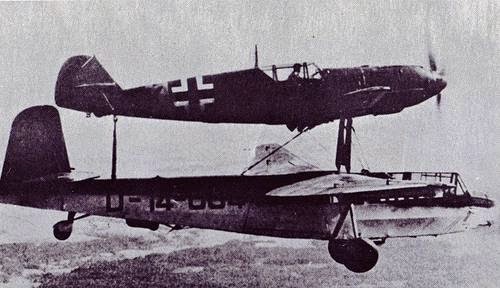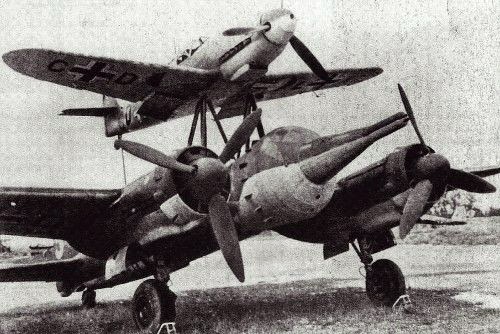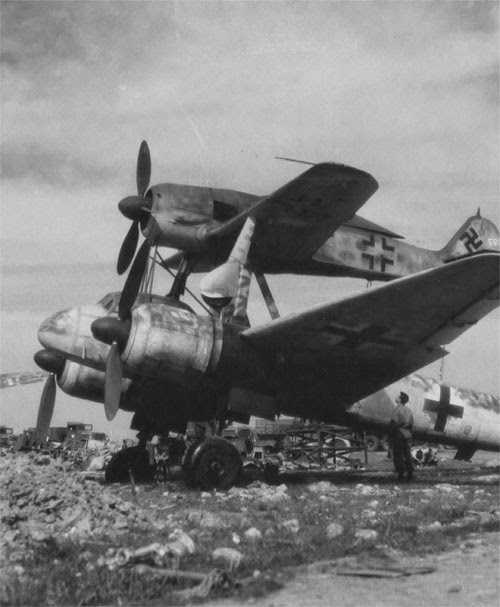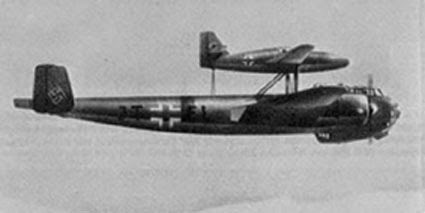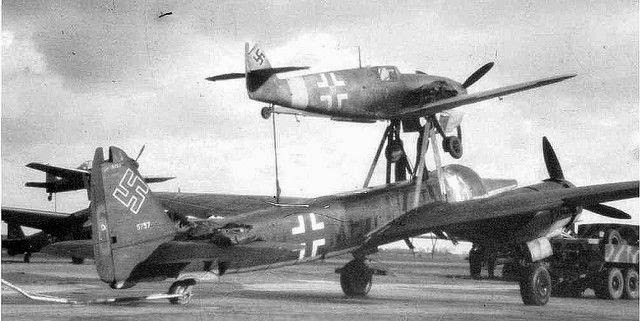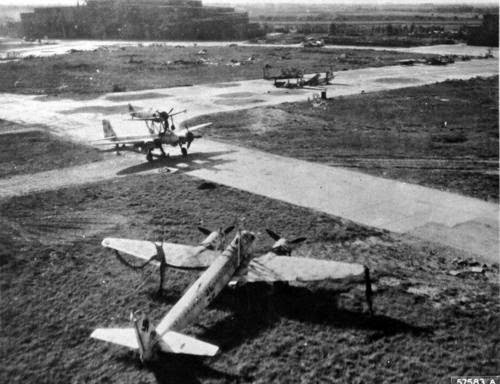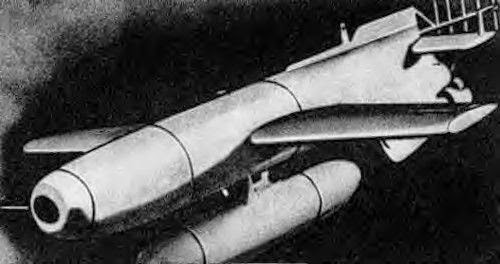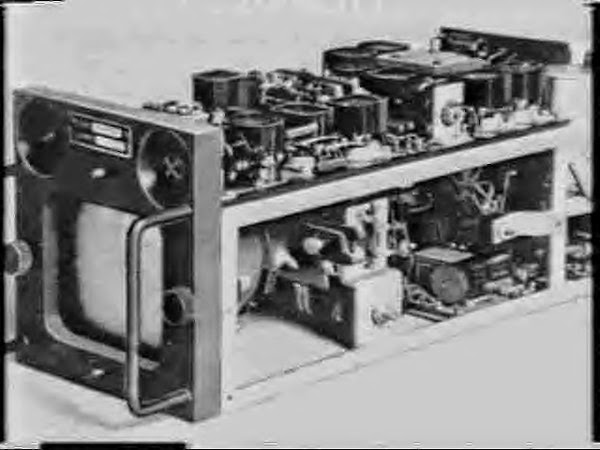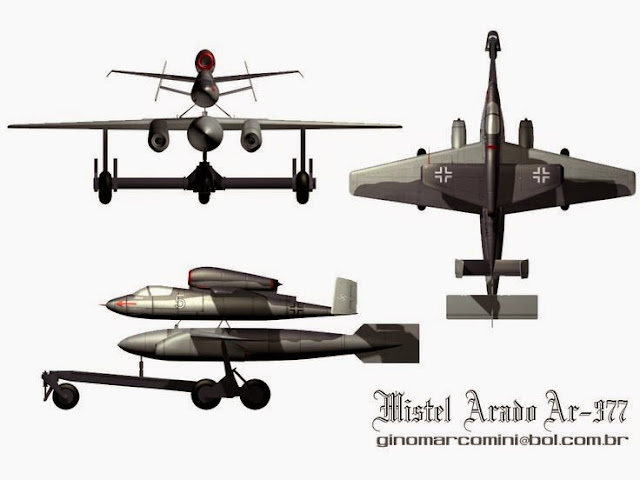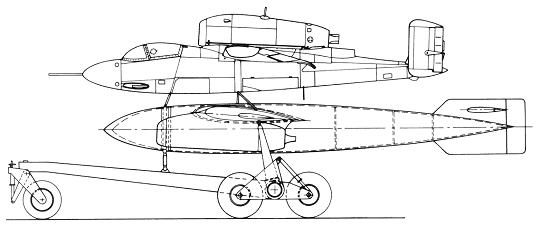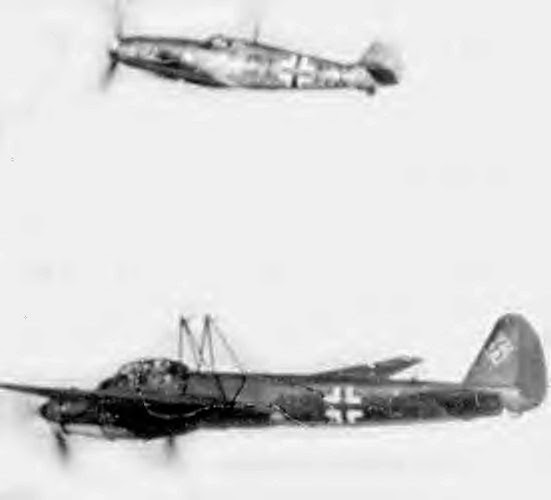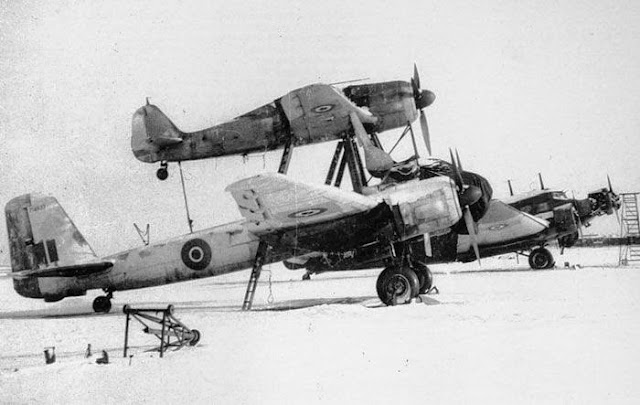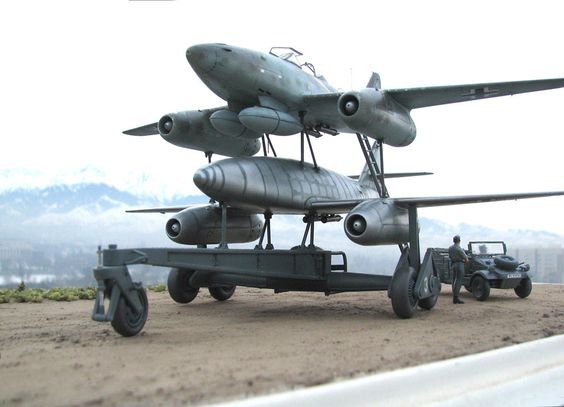 |
| Type XXI Walther U-Boat on display in Bremerhaven ("Wilhelm Bauer"). |
Submarines during World War I and most of World War II were essentially surface ships that could submerge for short periods of time. The secret to Allied success at defeating the U-boat menace was to locate them on the surface, then send forces to locate and sink them. That strategy worked because U-boats were unable to cruise for extended periods of time underwater. Unable, that is, until the Type XXI came along.
 |
| The U-3017 was a Type XXI U-Boat built for the German Kriegsmarine in the late World War II. She was laid down on 2 Sep 1944 at AG Weser, Bremen as 'work' 1176, launched on 5 Nov 1944 and went into service on 5 Jan 1945 under the command of Oblt. Rolf Lindschau. She was surrendered on 9 May 1945 at Horten, Norway then transferred to Oslo in May and arrived at Lisahally, Northern Ireland on 7 June for Operation Deadlight. |
The Germans had more experience with submarines than anyone else in the world. They had very nearly won World War I with them and had continued developing them during the interwar period despite being prohibited from doing so by the Treaty of Versailles. This was done clandestinely in other countries that Germany would later invade. However, money talks and the Germans had ready cash to create their tools of destruction using the facilities of their future victims.
 |
| Type XXI U-Boats at the end of World War II. |
The
World War II U-boat campaign, or the "Second Battle of the Atlantic" as it is often grandly called, peaked in 1942. The backbone of the U-boat fleet was the Type VII, a solid, dependable performer which had extended range using its noisy diesel engines. The diesel engines could not operate underwater, so it relied upon battery power there.
 |
| Here she is in all her glory. Type XII introduced streamlining in U-Boat design, resulting in a quantum leap in underwater performance. All submarines before this one were basically designed to submerge and stay under the surface in one place (sans minor pedestrian maneuvers using electric power). Type XXI could easily steam in circles around any Allied convoy - all underwater. |
The Type VII batteries were sufficient for brief periods underwater, but those U-boats could move neither quickly nor for extended periods unless they were on the surface. If they submerged, they basically were going to remain in the same area until they could surface. The Allies knew this, and they figured out that they merely had to spot where the U-boat submerged, mark the spot with dye, and then drop a depth charge pattern to sink the submerged craft. This strategy worked like a charm once you knew where the U-boat had submerged.
 |
| Type XXI U-Boat, U-3008, underway off Portsmouth Navy Yard, August 1946 |
After the U-boats experienced one last fling of torrid success at the beginning of 1943 due to diversion of Allied naval units to the invasion of North Africa, the Allies completely shut the Type VII U-boats down in March/April 1943. The British became expert at locating the U-boats in the Bay of Biscay as they were cruising to their stations in the Atlantic from occupied French ports. Trying to enter the Mediterranean became a suicide mission, with constant British patrols at the Straits of Gibraltar. Once they located a U-boat, the British could keep them it surveillance with flying boats until they submerged, vectoring in surface vessels to sink them. Coastal Command also could drop depth charges that would sink the U-boats if they submerged, knowing that the U-boats could not go very far underwater. Admiral Doenitz, desperate for a solution, ordered the U-boats to fight it out on the surface with the deck guns, but that strategy was a complete failure. The U-boats now weren't even safe at night, due to radar and powerful Leigh searchlights.
 |
| A captured Type XXI. |
The key problem obviously was that U-boats could not cruise underwater, and they were easily detectable above water with radar and Allied aircraft patrols. Thus, confronting an enemy that completely (oppressively, from the German viewpoint) dominated the surface and air, and facing radar surveillance that completely covered all the major U-boat routes such as across the Bay of Bengal, the German U-boat fleet became practically useless. In addition, even when a U-boat could make it out to its station on the convoy routes, it then would have to surface to get into attack position.
 |
| U-Boot Typ XXI U-2540 ("Wilhelm Bauer"). |
With the sea crawling with convoy escorts, surfacing quickly revealed the U-boat's position and brought attacks by depth charge if it submerged and gunfire if it remained on the surface. It was a completely hopeless proposition that would only result in the loss of U-boats to no purpose. The only solution was to make U-boats able to cruise to and from their stations completely submerged, thereby avoiding detection. That problem was solved definitively with the Type XXI.
 |
| Type XXI. |
The main innovation of Type XXI was two-fold: a dramatically streamlined hull; and greatly increased battery capacity. However, the advances in Type XXI went way beyond these essential improvements. The hull was streamlined in a teardrop fashion that subsequently has been proven to be the most aerodynamic shape, and now is favored by modern car manufacturers. Extensive use of electrical systems led to the boats being called "Elektroboote" (German: "electric boats"). Propulsion was supplied by:
Diesel/Electric
2× MAN M6V40/46KBB supercharged 6-cylinder diesel engines, 4,000 shp (3,000 kW)
2× SSW GU365/30 double-acting electric motors, 5,000 PS (3.7 MW)[1]
2 × SSW GV232/28 silent running electric motors, 226 shp (169 kW)
 |
| German Type XXI U-boat. |
The key to all this was a development that had been years in the making: the use of hydrogen peroxide ('perhydrol') as a fuel. This was an innovation from rocketry research carried out by Hellmuth Walter, and the same principle was used in the Me 163 Komet. The hydrogen peroxide was reduced chemically to gasses, and these gasses spun a turbine at 20,000 revolutions per minute. The reaction gasses spun the U-boat's propeller fast enough to propel the submarine. The power generated by the chemical reaction was combined with intermittent use of the conventional diesel engines to charge the ship's batteries, which powered the hydrogen peroxide reaction. The batteries became the U-boat's primary power source, and the diesel engines were used only occasionally (it took three hours) to charge the batteries. This completely flipped the paradigm of previous U-boats and made the U-boats true submarines.
 |
| U-2540, completed 24 February 1945, scuttled 4 May 1945, no patrols. |
A modern example of this principle is the Chevy Volt, which uses its vestigial internal combustion engine only to charge the batteries that actually run the vehicle and are usually plugged into outlets to charge. However, the Volt is open to the air, so it can use a standard internal combustion engine that burns gasoline to power the batteries. The Type XXI had the additional hurdle of not being open to the air and thus having to run on chemical reactions that did not produce carbon monoxide. Thus, the Type XXI was more advanced than the Volt, whose propulsive system is considered (regardless of the car's other qualities) to be the supreme automotive feat of the 21st Century.
 |
| The U-3008 was a Type XXI U-boat of German Kriegsmarine during World War II and served in the U.S. Navy for several years after World War II. Her keel was laid down on 2 July 1944 by AG Weser of Bremen, and she was commissioned on 19 October 1944 with Kapitänleutnant Fokko Schlömer in command. In March 1945 Schlömer was relieved by Kapitänleutnant Helmut Manseck, who commanded the boat until the German surrender on 8 May. |
To say that the Type XXI's propulsion system was ahead of its time is a vast understatement, and in fact, it was a bit too far ahead of its time for the Germans as well. They never did completely figure out the hydrogen peroxide mechanism and implement it in practical terms. To compensate, they greatly increased the battery banks and the diesel engines used to charge the batteries. The batteries were used to power the engines directly rather than relying upon the middle-man of the hydrogen peroxide reaction. This also worked sufficiently to put the Type XXI into service. Combined with the streamlined hull, the engines gave the Type XXI the ability to cruise underwater at 17.2 knots (31.9 km/hr (roughly 20 miles an hour) for short periods and to cruise for two or three days straight at 5 knots (9.3 km/hour or 5.8 mph). This was a huge improvement over the Type VII. With Schnorkel technology, theoretically, the Type XXI would never have to surface while on patrol.
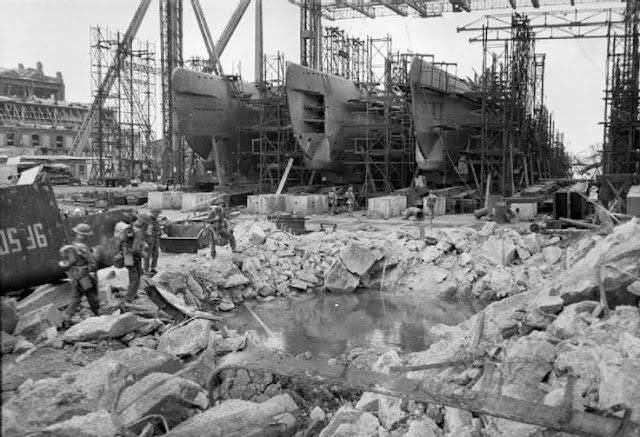 |
| U-boat Production: Three Type XXI submarines on a building slip at Hamburg right after the end of the war. Note the British troops on the left foreground. The XXI was a revolutionary design, the first sub that was truly an "electric boat" capable of great underwater range without the need to surface or cruise at snorkel depth for extended periods of time. |
Type XXI U-boats incorporated all sorts of other advances that distinguished it from previous U-boats or Allied submarines. It embodied a form of stealth technology, with its streamlined shape greatly reducing its radar signature when surfaced. In this sense, it was similar to the
Horten brothers' revolutionary flying wing that also was being built during the closing days of the war and had a reduced radar signature.
 |
| U-boot U 2450 moored in the old port of Bremerhaven, Germany as a permanent maritime museum. Built at the end of WW2, U 2540 was commissioned on Feb 25, 1945. On May 4, 1945, she was scuttled off the Flensburg Fjord near Kiel. In 1957 she was raised, underwent a complete refit at the HDW shipyards in Kiel, and was baptized, Wilhelm Bauer. She was commissioned into the new German Navy in 1958 as an experimental sub. She was finally decommissioned in Nov 1980. |
A novel hydraulic torpedo system featured quick reloading of all six forward torpedo tubes faster than the Type VII could reload one tube. Advanced sonar helped to guide the submarine into attack position. The craft also was more comfortable for the crew, including for the first time freezers for perishable food. The deck gun was removed to improve streamlining (there were so many convoy escorts that surface attacks had become obsolete), and there were anti-aircraft weapons built into the sail.
 |
| Type XXI view from the deck. |
Admiral Karl Doenitz relied upon the Type XXI U-boats to reinvigorate his campaign against the Allied fleets, which was struggling along at about 100,000 tons sunk a month - hardly anything worth mentioning compared to Allied ship construction of the period. Blohm & Voss of Hamburg, AG Weser of Bremen, and F. Schichau of Danzig were chosen to build the new craft beginning in 1943.
 |
| A Type XXI U-boat, U-3503, being raised by the Swedish Navy in 1946. John Adolfsson, Hono Fishing Museum, Sweden. |
Armaments Minister Albert Speer, facing problems everywhere with a collapsing economy and knowing that the new submarines were needed as soon as possible, made the fateful decision to have non-shipyard manufacturers make prefabricated pieces of the U-boats that would be assembled at the shipyards. This successfully dispersed the effort from oppressive Allied bombing raids but led to severe quality control problems where the pieces could be not fitted together without extensive re-working at the yard. As with so many other German decisions forced upon them by wartime exigencies, the decision was absolutely logical in the abstract and conceptually, while completely unworkable in practice - in other words, logical to a fault.
 |
| Elektroboote Type XXI U boat. |
In all, 118 of the Type XXI U-boats were built. It was a staggering achievement based upon slave labor and prisoners of war being forced to participate, and plans were for the yards to crank out three a week. However, the Allies were closing in, and bombing raids destroyed the main submarine pens at Farge, near Bremen, in March 1945. The Type XXI was extremely close to entering action - but not quite close enough.
 |
| Elektroboote Type XXI U boat. |
Only four of the Type XXI U-boats were completed before the end of the war, and only two (U-2511 and U-3008) actually went out on patrol. For all that effort, the Type XXI sank not a single Allied vessel, though the U-2511 was in a position to sink a British cruiser when the war ended. That is not to say that it had no effect on the war, however: one can easily imagine Adolf Hitler sitting in his bunker receiving daily reports on Type XXI and thus ordering his troops to fight on after the land war had become completely hopeless. The appointment of old U-boat chief Karl Doenitz as Hitler's successor undoubtedly flowed from this enticing promise of Type XXI boats.
 |
| Admiral Karl Doenitz reviewing a Type VII U-boat at St. Nazaire (Lothar Gunther, Federal Archive). |
The consequences were a little more meaningful and permanent for others. Hitler obstinately kept hundreds of thousands of men in the east defending the Courland pocket, men who easily could have been shipped home for the defense of Berlin. He justified this by claiming that "Admiral Doenitz says that giving it up would be ruinous for the Navy." Since the only part of the Navy that still stood any chance of making a difference in the war was the Type XXI U-boat, protecting that program as a top priority undoubtedly was a major part of Hitler's thinking. This condemned the overwhelming majority of those soldiers to death in Soviet captivity and, indeed, may have shortened the war.
 |
| U-2513 was a Type XXI U-boat of the German Kriegsmarine, that was operated by the United States Navy for several years after World War II. On 21 November 1946 President Harry S. Truman became the first American President to travel on a submarine when he visited U-2513. The sub went 440 feet (130 m) below the surface with the President on board, and a demonstration was made to him of the German schnorchel. |
The German Heer could not hold off the Allies forever, though, and the Allies headed straight for the Kriegsmarine harbors. The British and Soviets occupied the German Baltic ports where Type XXI boats were based in April 1945, and the Allies shared them amongst themselves according to the Potsdam Agreement (some were sunk pursuant in Operation Deadlight, the purposeful sinking of the German U-boats in the Atlantic). The remaining operational Type XXIs remained in service in France until 1967, in the Soviet Union for testing purposes until 1973, in the United Kingdom until 1949, and in the United States (U-2513 and U-3008) until 1956. Harry S. Truman became the first United States President aboard a submarine when he traveled in U-2513 in November 1946 and submerged to a depth of 130 meters (440 feet). Type XXI greatly influenced all post-war submarine development by the major powers, such as the Soviet “Whiskey” class and (based on Soviet designs) a flotilla of Chinese submarines. Some designs which are direct descendants remain in use today.
 |
| Unfinished German U-boats, Bremen, Germany, 1945. |
U-2540, which was scuttled in order to avoid capture, was raised, renamed Wilhem Bauer, and operated until 1982 by the German Navy, the Bundesmarine. It remains on display at the Deutsches Schiffahrtsmuseum (German Maritime Museum) in Bremerhaven, Germany.
Type XXIII
 |
| U-2326 (colorized). |
The Germans also used or planned to use the advanced propulsion concept in a variety of different types. The U-2326 was a Type XXIII submarine of the German Kriegsmarine during World War II. Type XXIII submarines were the first so-called Elektro boats to become operational. They were small coastal submarines designed to operate in the shallow waters of the North Sea, Black Sea and the Mediterranean Sea, where larger Type XXI Elektro boats were at risk in World War II.
Photos of the Wilhelm Bauer
Photos of U-2511, Sunk off Ireland in Operation Deadlight
 |
| German Type XXI U boat U 2511 wreckage off the coast of N. Ireland. |
Three Type XXI U-boats That Survive for Future Historians
Things were quite chaotic at the end of World War II. When the British occupied Hamburg after a fierce two-week battle against the 1st Parachute Army on 3 May 1945, they did not have time for extensive examination of every particular in the devastated port city. German weapons had to be crossed off the list as having been rendered harmless as the British rolled onward toward the last seat of the Third Reich government at Flensburg.

So, instead of sending scientists down to study the odd U-boats that they had discovered or readying them for Operation Deadlight, the British simply blew up their fortified bunker. This was a mistake, as these particular U-boats merited close study as forerunners of US and British version, but there was a war on. However, as the British and the French were to learn a few months later in Berlin when they tried to blow up the gigantic Flak Towers (they are still there, but also buried), sometimes it is not so easy to get rid of massive structures. The roof of the U-boat bunker partially collapsed, trapping the three U-boats, but did not destroy them. Since the boats weren't going anywhere anytime soon, the British promptly moved on and forgot all about them.
Some Germans did not forget. Someone made an attempt to scrap them in the ’40s-’50s, but with the roof ready to collapse at any time, it was considered too dangerous and everybody forgot about them again. The boats were virtually missing until 1985 when the boats were discovered through research by Jak P Mallmann-Showell, Wolfgang Hirschfeld and Walter Cloots in the mostly demolished Elbe II U-boat bunker in Hamburg. However, at this point the boats had lost their notoriety and had become mere curiosities, so nothing was done about them at this point. This time, though, they were not forgotten.
 |
| The bow of U-3004 inside the Elbe II bunker. – Photo by Carl. |
Thus, the three boats stayed somewhat intact until the 1990s. At that point, the German government - somewhat like the British in 1945 - crossed them off its list of worries in the easiest manner possible. During that state in German culture, anything related to World War II was a major embarrassment, no matter how interesting to war buffs. This time, they got rid of this nuisance by filling the massive U-boat bunker with gravel and concrete. They simply buried the boats and then turned the area into a parking lot. So, the boats remain completely intact but for whatever salvaging was done to them right after the war, but entombed and inaccessible.
 |
| Hatch 5 of U-3506 inside the Elbe II bunker. – Photo by Carl. |
The Elbe II bunker is located on the southern bank of the Elbe river at the Vulkanhafen. This area is within the Freeport of Hamburg and to access it you should have to present your passport. The advanced Type XXI U-boats remain there, buried, awaiting future excavation in perhaps hundreds of years when someone is in for a real shock when they excavate that area for an office building or dock.
2020



